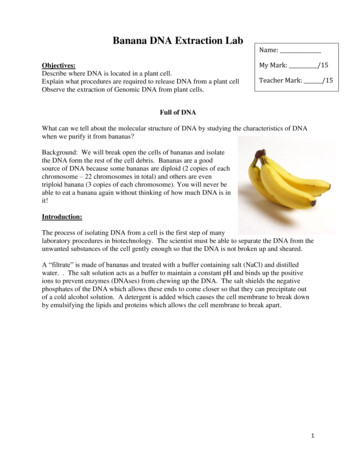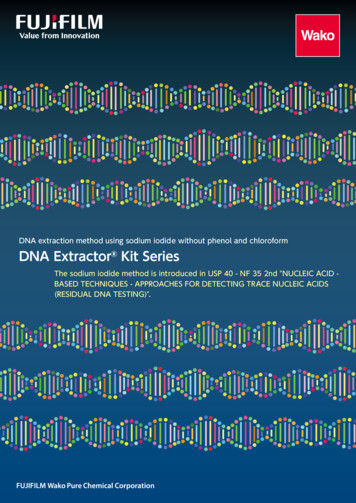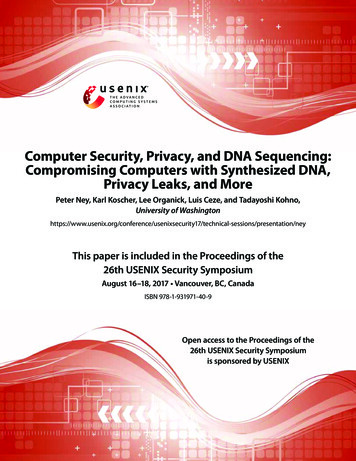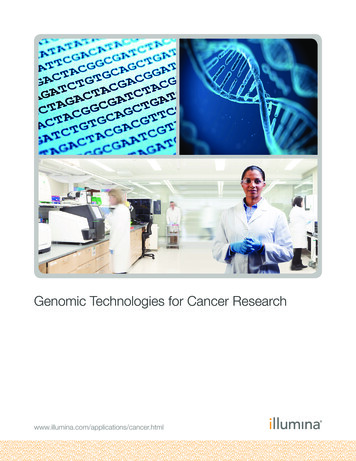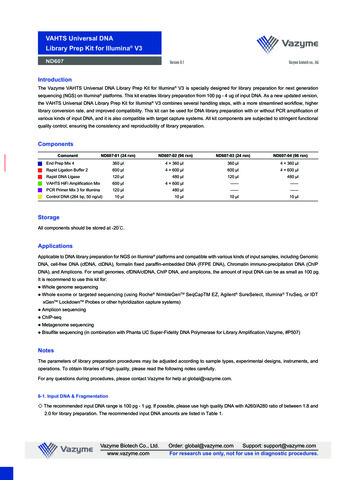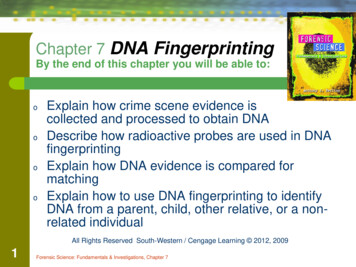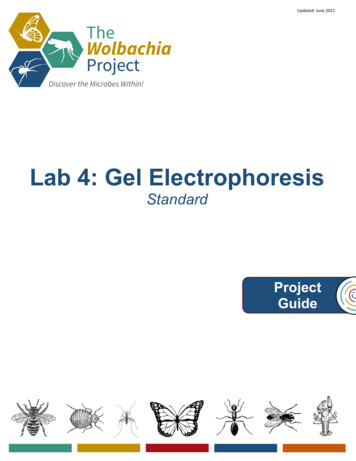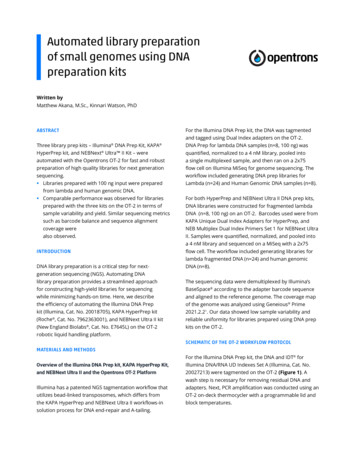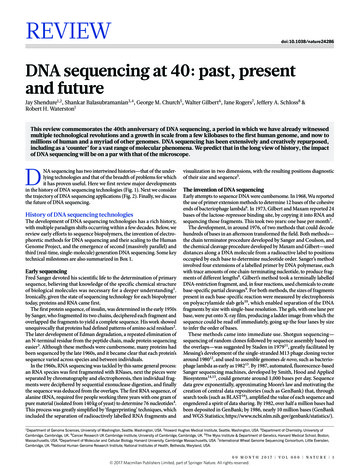
Transcription
Reviewdoi:10.1038/nature24286DNA sequencing at 40: past, presentand futureJay Shendure1,2, Shankar Balasubramanian3,4, George M. Church5, Walter Gilbert6, Jane Rogers7, Jeffery A. Schloss8 &Robert H. Waterston1This review commemorates the 40th anniversary of DNA sequencing, a period in which we have already witnessedmultiple technological revolutions and a growth in scale from a few kilobases to the first human genome, and now tomillions of human and a myriad of other genomes. DNA sequencing has been extensively and creatively repurposed,including as a ‘counter’ for a vast range of molecular phenomena. We predict that in the long view of history, the impactof DNA sequencing will be on a par with that of the microscope.DNA sequencing has two intertwined histories—that of the underlying technologies and that of the breadth of problems for whichit has proven useful. Here we first review major developmentsin the history of DNA sequencing technologies (Fig. 1). Next we considerthe trajectory of DNA sequencing applications (Fig. 2). Finally, we discussthe future of DNA sequencing.History of DNA sequencing technologiesThe development of DNA sequencing technologies has a rich history,with multiple paradigm shifts occurring within a few decades. Below, wereview early efforts to sequence biopolymers, the invention of electrophoretic methods for DNA sequencing and their scaling to the HumanGenome Project, and the emergence of second (massively parallel) andthird (real-time, single-molecule) generation DNA sequencing. Some keytechnical milestones are also summarized in Box 1.Early sequencingFred Sanger devoted his scientific life to the determination of p rimarysequence, believing that knowledge of the specific chemical structureof biological molecules was necessary for a deeper understanding1.Ironically, given the state of sequencing technology for each biopolymertoday, proteins and RNA came first.The first protein sequence, of insulin, was determined in the early 1950sby Sanger, who fragmented its two chains, deciphered each fragment andoverlapped the fragments to yield a complete sequence. His work showedunequivocally that proteins had defined patterns of amino acid residues2.The later development of Edman degradation, a repeated elimination ofan N-terminal residue from the peptide chain, made protein sequencingeasier3. Although these methods were cumbersome, many proteins hadbeen sequenced by the late 1960s, and it became clear that each protein’ssequence varied across species and between individuals.In the 1960s, RNA sequencing was tackled by this same general process:an RNA species was first fragmented with RNases, next the pieces wereseparated by chromatography and electrophoresis, then individual fragments were deciphered by sequential exonuclease digestion, and finallythe sequence was deduced from the overlaps. The first RNA sequence, ofalanine tRNA, required five people working three years with one gram ofpure material (isolated from 140 kg of yeast) to determine 76 nucleotides4.This process was greatly simplified by ‘fingerprinting’ techniques, whichincluded the separation of radioactively labelled RNA fragments andv isualization in two dimensions, with the resulting positions diagnosticof their size and sequence5.The invention of DNA sequencingEarly attempts to sequence DNA were cumbersome. In 1968, Wu reportedthe use of primer extension methods to determine 12 bases of the cohesiveends of bacteriophage lambda6. In 1973, Gilbert and Maxam reported 24bases of the lactose-repressor binding site, by copying it into RNA andsequencing those fragments. This took two years: one base per month7.The development, in around 1976, of two methods that could decodehundreds of bases in an afternoon transformed the field. Both methods—the chain terminator procedure developed by Sanger and Coulson, andthe chemical cleavage procedure developed by Maxam and Gilbert—useddistances along a DNA molecule from a radioactive label to positionsoccupied by each base to determine nucleotide order. Sanger’s methodinvolved four extensions of a labelled primer by DNA polymerase, eachwith trace amounts of one chain-terminating nucleotide, to produce fragments of different lengths8. Gilbert’s method took a terminally labelledDNA-restriction fragment, and, in four reactions, used chemicals to createbase-specific p artial cleavages9. For both methods, the sizes of fragmentspresent in each base-specific reaction were measured by electrophoresison polyacrylamide slab gels10, which enabled separation of the DNAfragments by size with single-base resolution. The gels, with one lane perbase, were put onto X-ray film, producing a ladder image from which thesequence could be read off immediately, going up the four lanes by sizeto infer the order of bases.These methods came into immediate use. Shotgun sequencing—sequencing of random clones followed by sequence assembly based onthe overlaps—was suggested by Staden in 197911, greatly facilitated byMessing’s development of the single-stranded M13 phage cloning vectoraround 198012, and used to assemble genomes de novo, such as bacteriophage lambda as early as 198213. By 1987, automated, fluorescence-basedSanger sequencing machines, developed by Smith, Hood and AppliedBiosystems14,15, could generate around 1,000 bases per day. Sequencedata grew exponentially, approximating Moore’s law and motivating thecreation of central data repositories (such as GenBank) that, throughsearch tools (such as BLAST16), amplified the value of each sequence andengendered a spirit of data sharing. By 1982, over half a million bases hadbeen deposited in GenBank; by 1986, nearly 10 million bases (GenBankand WGS Statistics; 1Department of Genome Sciences, University of Washington, Seattle, Washington, USA. 2Howard Hughes Medical Institute, Seattle, Washington, USA. 3Department of Chemistry, University ofCambridge, Cambridge, UK. 4Cancer Research UK Cambridge Institute, University of Cambridge, Cambridge, UK. 5The Wyss Institute & Department of Genetics, Harvard Medical School, Boston,Massachusetts, USA. 6Department of Molecular and Cellular Biology, Harvard University, Cambridge Massachusetts, USA. 7International Wheat Genome Sequencing Consortium, Little Eversden,Cambridge, UK. 8National Human Genome Research Institute, National Institutes of Health, Bethesda, Maryland, USA.0 0 M o n t h 2 0 1 7 VO L 0 0 0 NAT U R E 1 2017 Macmillan Publishers Limited, part of Springer Nature. All rights reserved.
RESEARCH ReviewFirst generation sequencing (Sanger)1 Genomic DNA2 FragmentedDNA3 Cloning and amplification3′. * & 7 * 7 & & * * & * 7 * .5′4 Sequencing5′. & 7 * 7 .& 7 * 7 & .& 7 * 7 & 7 .& 7 * 7 & 7 .5 Detection.& 7 * 7 & 7 * .&7* 7&7 **&7&*& &7.& 7 * 7 & 7 * * & 7 & * & & 7 .Second generation sequencing (massively parallel)1 Genomic DNA2 Fragmented DNA3 Adaptor ligation4 AmplificationNative DNA5 DetectionCycle 1&Cycle 27Cycle 3*Cycle 4 3′. * & 7 * 7 & & * * & * 7 * .5′5′. & 7 * .Third generation sequencing(Real-time, single molecule)&7* 7&7 **&7&*& &7Figure 1 DNA sequencing technologies. Schematic examples of first,second and third generation sequencing are shown. Second generationsequencing is also referred to as next-generation sequencing (NGS)in the text.Scaling to the human genomeFor the ‘hierarchical shotgun’ strategy that emerged as the workhorseof the Human Genome Project (HGP), large fragments of the humangenome were cloned into bacterial artificial chromosomes (BACs). DNAfrom each BAC was fragmented, size-selected and sub-cloned. Individualclones were picked and grown, and the DNA was isolated. The purifiedDNA was used as a template for automated Sanger sequencing, the signalwas extracted from laser-scanned images of the gels, and bases were calledto finally produce the sequence. The fact that this process involved manyindependent steps, each of which had to work well, led sceptics to doubtit could ever be made efficient enough to sequence the human genomeat any reasonable cost.Indeed, as efforts to sequence larger genomes took shape, it became clearthat the scale and efficiency of each step needed to be vastly increased. Thiswas achieved in fits and spurts in the 1990s. Noteworthy improvementsincluded: (1) a switch from dye-labelled primers to dye- labelled terminators, which allowed one rather than four sequencing reactions17; (2) amutant T7 DNA polymerase that more readily incorporated dye-labelledterminators18; (3) linear amplification reactions, which greatly reducedtemplate requirements and facilitated miniaturization19; (4) a magneticbead-based DNA purification method that simplified automation of presequencing steps20; (5) methods enabling sequencing of double-strandedDNA, which enabled the use of plasmid clones and therefore paired-endsequencing; (6) capillary electrophoresis, which eliminated the pouringand loading of gels, while also simplifying the extraction and interpretationof the fluorescent signal21; (7) adoption of industrial processes to maximizeefficiencies and minimize errors (for example, automation, quality control,standard operating procedures, and so on).Wet laboratory protocols were only half the challenge. Substantial effortwas invested into the development of software to track clones, and intothe interpretation and assembly of sequence data. For example, manualediting of the sequence reads was replaced by the development of phred,which introduced reliable quality metrics for base calls and helped sortout closely related repeat sequences22. Individual reads were then assembled from overlaps in a quality-aware fashion to generate long, continuousstretches of sequence. As more complex genomes were tackled, repetitivesequences were increasingly confounding. Even after deep shotgunsequencing of a BAC, some sequences were not represented, resultingin discontinuities that had to be tackled with other methods. Pairedend sequencing23 helped to link contigs into gapped scaffolds that couldbe followed up by directed sequencing to close gaps. Some problems wereonly resolved by eye; scientists who were trained ‘finishers’ assessed thequality and signed off on the assembled sequence of individual clones22.Although the process remained stable in its outlines, rapid-fireimprovements led to steady declines in the cost throughout the 1990s,while parallel advances in computing increasingly replaced human decision making. By 2001, a small number of academic genome centreswere operating automated production lines generating up to 10 millionbases per day. Software for genome assembly matured both inside andoutside of the HGP, with tools, such as phrap, the TIGR assembler and theCelera assembler, able to handle genomes of increasing c omplexity22,24,25.A yearly doubling in capacity enabled the successful completion ofhigh-quality genomes beginning with Haemophilus influenza (around2 Mb, 1995) followed quickly by Saccharomyces cerevisiae (around 12 Mb,1996) and Caenorhabditis elegans (around 100 Mb, 1998)26–28. TheHGP’s human genome, which is 30 times the size of C. elegans and withmuch more repetitive content, came first as a draft (2001) and then as a finished sequence (2004)29,30. The HGP was paralleled by a private effortto sequence a human genome by Craig Venter and Celera (2001)31 witha whole-genome shotgun strategy piloted on Drosophila melanogaster(around 175 Mb; 2000)32. The strategic contrasts between these projectsare further discussed below.By 2004, instruments were churning out 600–700 bp at a cost of US 1per read, but creating additional improvements was an increasingly marginal exercise. Furthermore, with the completion of the HGP, the futureof large-scale DNA sequencing was unclear.Massively parallel DNA sequencingThroughout the 1980s and 1990s, several groups explored alternatives toelectrophoretic sequencing. Although these efforts did not pay off untilafter the HGP, within a decade of its completion, ‘massively parallel’ or‘next-generation’ DNA sequencing (NGS) almost completely supersededSanger sequencing. NGS technologies sharply depart from electrophoretic sequencing in several ways, but the key change is multiplexing.Instead of one tube per reaction, a complex library of DNA templates isdensely immobilized onto a two-dimensional surface, with all t emplatesaccessible to a single reagent volume. Rather than bacterial cloning,in vitro amplification generates copies of each template to be sequenced.Finally, instead of measuring fragment lengths, sequencing comprisescycles of biochemistry (for example, polymerase-mediated incorporation of fluorescently labelled nucleotides) and imaging, also known as‘sequencing-by-synthesis’ (SBS).Although amplification is not strictly necessary (for example, single-molecule SBS33–35), the dense multiplexing of NGS, with millionsto billions of immobilized templates, was largely enabled by clonal in vitroamplification. The simplest approach, termed ‘polonies’ or ‘bridge amplification’, involves amplifying a complex template library with p rimersimmobilized on a surface, such that copies of each template remain tightlyclustered36–39. Alternatively, clonal PCR can be performed in an emulsion,2 NAT U R E VO L 0 0 0 0 0 m o n t h 2 0 1 7 2017 Macmillan Publishers Limited, part of Springer Nature. All rights reserved.
Review RESEARCHDe novo genome assemblyShort readsSequenceoverlapsContigsLongrange linkScaffoldChromosomeGenome resequencingClinical applications (NIPT)Individual1* &7 * 7&&* *&*7* 2* &7 * 7 &* *&*7* 3* &* * 7&&*&*&*7* MaternalbloodplasmaMaternalDNA.7.5billion* &7 * 7&&* *&*&* Sites ofvariation* &7 * 7&&* *&*7* Sequencers as counting devicesFetal DNARibosomal translationRNA transcriptionChromatin accessibilityFigure 2 DNA sequencing applications. Major categories of theapplication of DNA sequencing include de novo genome assembly,individual genome resequencing, clinical applications such as non-invasiveprenatal testing, and using sequencers as counting devices for a broadrange of biochemical or molecular phenomena.such that copies of each template are immobilized on beads that are thenarrayed on a surface for sequencing40–42. A third approach involves rollingcircle amplification in solution to generate clonal ‘nanoballs’ that arearrayed and sequenced43.For SBS, there were three main strategies. The pyrosequencingapproach of Ronaghi and Nyrèn involves discrete, step-wise additionof each deoxynucleotide (dNTP). Incorporation of dNTPs releasespyrophos phate, which powers the generation of light by firefly luciferase44. With an analogous approach, natural dNTP incorporationscan be detected with an ion-sensitive field effect transistor45,46. A secondstrategy uses the specificity of DNA ligases to attach fluorescent oligonucleotides to templates in a sequence-dependent manner41,43,47,48. A thirdapproach, which has proven the most durable, involves the stepwise,polymerase-mediated incorporation of fluorescently labelled deoxynucleotides33,34,49. Critical to the success of polymerase-mediated SBS, wasthe development of reversibly terminating, reversibly fluorescent dNTPs,and a suitably engineered polymerase50, such that each template incorporates one and only one dNTP on each cycle. After imaging to determine which of four colours was incorporated by each template on thesurface, both blocking and fluorescent groups are removed to set up thenext extension51–53; this general approach was used by Solexa, foundedby Balasubramanian and Klenerman in 1998.The first integrated NGS platforms came in 2005, with resequencingof Escherichia coli by Shendure, Porreca, Mitra and Church41, de novoassembly of Mycoplasma genitalium by Margulies, Rothberg and 454(ref. 40), and resequencing of phiX174 and a human BAC by Solexa54.These studies demonstrated how useful even very short reads are, givena reference genome to which to map them. Within three years, humangenome resequencing would become practical on the Solexa platformwith 35-bp paired reads55.In 2005, 454 released the first commercial NGS instrument. In thewake of the HGP, large-scale sequencing was still the provenance of a fewgenome centres. With 454 and other competing instruments that followedclosely after, individual laboratories could instantly access the capacity ofan entire HGP-era genome centre. This ‘democratization’ of sequencingcapacity had a profound impact on the culture and composition of thegenomics field, with new methods, results, genomes and other innovations arising from all corners.In contrast to the monopoly of Applied Biosystems during the HGP,several companies, including 454 (acquired by Roche), Solexa (acquiredby Illumina), Agencourt 47,48 (acquired by Applied Biosystems),Helicos34,35 (founded by Quake), Complete Genomics43 (founded byDrmanac) and Ion Torrent46 (founded by Rothberg), intensely competedon NGS, resulting in a rapidly changing landscape with new instrumentsthat were flashily introduced at the annual Advances in Genome Biologyand Technology (AGBT) meeting in Marco Island, Florida. Between 2007and 2012, the raw, per-base cost of DNA sequencing plummeted by fourorders of magnitude56.Since 2012, the pace of improvement has slowed, as has the c ompetition.The 454, SOLiD and Helicos platforms are no longer being developed,and the Illumina platform is dominant (although Complete Genomics43remains a potential competitor). Nonetheless, it is astonishing to considerhow far we have come since the inception of NGS in 2005. Read lengths,although still shorter than Sanger sequencing, are in the low hundredsof bases, and mostly over 99.9% accurate. Over a billion independentreads, totalling a terabase of sequence, can be generated in two days byone graduate student on one instrument (Illumina NovaSeq) for a fewthousand dollars. This exceeds the approximately 23 gigabases that weregenerated for the HGP’s draft human genome by a factor of 40.Real-time, single-molecule sequencingNearly all of the aforementioned platforms require template a mplification.However, the downsides of amplification include copying errors,sequence-dependent biases and information loss (for example,methylation), not to mention added time and complexity. In an idealworld, sequencing would be native, accurate and without read-lengthlimitations. To reach this goal, stretching back to the 1980s, a handfulof groups explored even more radical approaches than NGS. Many ofthese were dead ends, but at least two approaches were not, as these haverecently given rise to real-time, single-molecule sequencing platformsthat threaten to upend the field once again.A first approach, initiated by Webb and Craighead and further developed by Korlach, Turner and Pacific Biosciences (PacBio), is to optically observe polymerase-mediated synthesis in real time57,58. A zero modewaveguide, a hole less than half the wavelength of light, limits fluorescent excitation to a tiny volume within which a single polymerase and its template reside. Therefore, only fluorescently labelled nucleotides incorporated into the growing DNA chain emit signals of sufficient durationto be ‘called’. The engineered polymerase is highly processive; reads over10 kb are typical, with some reads approaching 100 kb. The throughput ofPacBio is still over an order of magnitude less than the highest-throughputNGS platforms, such as Illumina, but not so far from where NGS platformswere a few years ago. Error rates are very high (around 10%) but randomlydistributed. PacBio’s combination of minimal bias (for example, toleranceof extreme GC content), random errors, long reads and redundant coverage can result in de novo assemblies of unparalleled quality with respectto accuracy and contiguity, for many species exceeding what would bepossible even with efforts similar to the HGP.A second approach is nanopore sequencing. This concept, which wasfirst hypothesized in the 1980s59–61, is based on the idea that patterns in0 0 M o n t h 2 0 1 7 VO L 0 0 0 NAT U R E 3 2017 Macmillan Publishers Limited, part of Springer Nature. All rights reserved.
RESEARCH ReviewBox 1The milestones listed below correspond to key developments inthe evolution of sequencing technologies. This is a large topic, andwe apologize for any omissions.Technical milestones1953: Sequencing of insulin protein21965: Sequencing of alanine tRNA41968: Sequencing of cohesive ends of phage lambda DNA61977: Maxam–Gilbert sequencing91977: Sanger sequencing81981: Messing’s M13 phage vector121986–1987: Fluorescent detection in electrophoreticsequencing14,15,171987: Sequenase181988: Early example of sequencing by stepwise dNTPincorporation1391990: Paired-end sequencing231992: Bodipy dyes1401993: In vitro RNA colonies371996: Pyrosequencing441999: In vitro DNA colonies in gels382000: Massively parallel signature sequencing by ligation472003: Emulsion PCR to generate in vitro DNA colonies on beads422003: Single-molecule massively parallel sequencing-by-synthesis33,342003: Zero-mode waveguides for single-molecule analysis572003: Sequencing by synthesis of in vitro DNA colonies in gels492005: Four-colour reversible terminators51–532005: Sequencing by ligation of in vitro DNA colonies on beads412007: Large-scale targeted sequence capture93–962010: Direct detection of DNA methylation during single-moleculesequencing652010: Single-base resolution electron tunnelling through a solidstate detector1412011: Semiconductor sequencing by proton detection1422012: Reduction to practice of nanopore sequencing143,1442012: Single-stranded library preparation method for ancient DNA145the flow of ions, which occur when a single-stranded DNA moleculepasses through a narrow channel, will reveal the primary sequence ofthe strand. Decades of work were required to go from concept to reality.Firstly, electric field-driven transport of DNA through a nanometre-scalepore is so fast that the number of ions per nucleotide is insufficient toyield an adequate signal. Solutions have eventually been developed tothese and other challenges, including interposing an enzyme as a ‘ratchet’,identifying and engineering improved nucleopore proteins, and betteranalytics of the resulting signals62. These advances recently culminated insuccessful nanopore sequencing, in both academia63 and industry, mostprominently by Oxford Nanopore Technologies (ONT), founded byBayley in 2005. Sequence read lengths of ONT are on par with or exceedthe reads generated by PacBio; with the longest obtained reads presentlyat 900 kilobases (ref. 64). A major differentiator from other sequencingtechnologies is the extreme portability of nanopore devices, which can beas small as a memory (USB) stick, because they rely on the detection ofelectronic, rather than optical, signals. Important challenges remain (forexample, errors may not be randomly distributed), but progress is rapid.Nucleic-acid sequencing would ideally also capture DNA modifications. Indeed, both PacBio and nanopore sequencing havedemonstrated the detection of native covalent modifications, such asmethylation64,65. Single-molecule methods also open up the intriguingpossibility of directly sequencing RNA66,67 or even proteins68–71.Since 1977, DNA-sequencing technology has evolved at a fast paceand the landscape continues to change shift under our feet. AlthoughIllumina is presently the dominant supplier of sequencing instruments,the commercial market is no longer monolithic and other technologiesmay successfully occupy important niches (for example, PacBio forde novo assembly and ONT for portable sequencing). Neither NGS norsingle-molecule methods have fully plateaued in cost and throughput,and there are additional concepts that are still in development, which arenot discussed here (for example, solid-state pores and electron microscopy)70,71. Not all will work out, but as the above examples make clear,transformative sequencing technologies can take decades to mature.Applications of DNA sequencingThe range and scope of DNA sequencing applications has also expandedover the past few decades, shaped in part by the evolving constraintsof sequencing technologies. Below we review key areas of application including de novo genome assembly, individual genome resequencing,sequencing in the clinic and the transformation of sequencers into molecular counting devices. Some key milestones for the generation ofreference genomes and development of applications and software aresummarized in Box 2.De novo genome assemblyFor its first 25 years, the primary purpose of DNA sequencing was thepartial or complete sequencing of genomes. Indeed, the inception of Sangersequencing in 1977 included the first genome (phiX174; 5.4 kb), essentially assembled by hand72. However, DNA sequencing was only one ofseveral technologies that enabled assembly of larger genomes. If the DNAsequence was random, arbitrarily large genomes could be assembled tocompletion solely based on fragment overlaps. However, it is not random,and the combination of repetitive sequences and technical biases makesit impossible to obtain high-quality assemblies of large genomes fromkilobase-scale reads alone. Additional ‘contiguity information’ is required.For the HGP29,30, these additional sources of contiguity informationincluded the following. (1) Genetic maps, which were based on the segregation of genetic polymorphisms through pedigrees, that providedorthogonal information about the order of sequences locally and at thescale of chromosomes. (2) Physical maps, for which BACs were cloned,restriction-enzyme ‘fingerprinted’ to identify overlaps and ordered into a‘tiling path’ that spanned the genome. Clones were individually shotgunsequenced and assembled, thereby isolating different repeat copies from oneanother, and then further ordered and assembled. (3) Paired-end sequencing, introduced by Ansorge in 199023, comprises sequencing into both endsof a DNA fragment of approximately known length, e ffectively linking thoseend-sequences. Depending on the cloning method, the spanned lengthcould range from a few kilobases to a few hundred kilobases. Sequencecoverage at 8–10-fold redundancy, coupled to these sources of contiguityinformation, enabled not only genome assembly, but also improved qualityto about 1 error per 100,000 bases for most of the genome. Additional,focused experiments were performed to fill the gaps or clarify ambiguities.The Celera effort went straight to paired-end sequencing, eschewingphysical maps as an intermediate31. An important advance was the transition from greedy algorithms, such as phrap and the TIGR assembler,to the Celera assembler’s graph-based approach (overlap–layout– consensus)22,24,25. Although Celera had a reasonable strategy for a draftgenome, because of the pervasiveness of repetitive sequences, it did not,by itself, result in a high-quality reference, such as the one produced bythe HGP’s clone-based approach. The current human reference genomedescends from the HGP’s 2004 product30, with continuous work by theGenome Reference Consortium to further improve it, including regularreleases of reference genome updates73.With the advent of NGS in 2005, the number of de novo assembliesincreased vastly. The seemingly disastrous combination of short readsand repetitive genomes was overcome by new assembly algorithms basedon de Bruijn graphs (for example, EULER and Velvet)74,75. Nonetheless,particularly when applied to larger genomes and when compared to thegenomes of the HGP, their quality was, on average, quite poor. Althoughshorter read lengths are partly to blame, this is usually overstated. Instead,a principal reason for the poorer quality was the paucity of contiguity4 NAT U R E VO L 0 0 0 0 0 m o n t h 2 0 1 7 2017 Macmillan Publishers Limited, part of Springer Nature. All rights reserved.
Review RESEARCHBox 2The milestones listed below correspond to key developments inthe availability of new reference genomes, new sequencing-relatedcomputational tools and the applications of DNA sequencing in newways or to new areas. These are large topics, and we apologize forany omissions.Genome milestones1977: Bacteriophage ΦX174 (ref. 72)1982: Bacteriophage lambda131995: Haemophilus influenzae261996: Saccharomyces cerevisiae271998: Caenorhabditis elegans282000: Drosophila melanogaster322000: Arabidopsis thaliana1462001: Homo sapiens29–312002: Mus musculus1472004: Rattus norvegicus1482005: Pan troglodytes1492005: Oryza sativa1502007: Cyanidioschyzon merolae1262009: Zea mays1512010: Neanderthal882012: Denisovan1452013: The HeLa cell line152,1532013: Danio rerio1542017: Xenopus laevis155Computational milestones1981: Smith–Waterman1561982: GenBank 1990: BLAST161995: TIGR assembler241996: RepeatMasker1997: GENSCAN1571998: phred, phrap, consed222000: Celera assembler252001: Bioconductor2001: EULER742002: BLAT1582002: UCSC Genome Browser1592002: Ensembl160methods to complement NGS. Paired-end sequencing was possible withNGS, but in vitro library methods were more restricted with respect to thedistances that could be spanned. Furthermore, the field lacked ‘massivelyparallel’ equivalents of genetic and physical maps.This ‘dark’ period notwithstanding, there are good reasons to be optimistic about the future of de novo assembly. Firstly, in vitro methods thatsubsample high molecular weight (HMW) genomic fragments, analogousto hierarchical shotgun sequencing, have recently been developed76,77.Secondly, methods, such as Hi-C (genome-wide chromosome conformation capture) and optical mapping, provide scalable, cost-effective meansof scaffolding genomes into chromosome-scale assemblies78–80. Finally,the read lengths of PacBio and ONT sequencing have risen to hundredsof kilobases, and are now more limited by the preparation of HMWDNA than by the sequencing its
Church 5, walter Gilbert 6, Jane Rogers , Jeffery A. Schloss 8 & Robert h. w aterston 1 D NA sequencing has two intertwined histories—that of the under - lying technologies and that of the breadth of problems for which it has proven useful. Here we first review major developments in the history of DNA sequencing technologies (Fig. 1). Next we .

